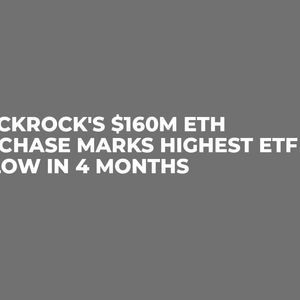XRP Ledger EVM: Unleashing a New Era for DeFi and Smart Contracts
7 min read
BitcoinWorld XRP Ledger EVM: Unleashing a New Era for DeFi and Smart Contracts Get ready, XRP community! A major upgrade is on the horizon that could fundamentally change how you interact with the XRP Ledger (XRPL). David Schwartz, the chief technology officer at Ripple, recently dropped some exciting news at the APEX 2025 conference in Singapore: the highly anticipated XRP Ledger EVM compatible sidechain is expected to go live in the second quarter of 2025. This isn’t just a technical update; it’s a bridge connecting the XRPL to the vast and dynamic world of Ethereum’s ecosystem. For years, Ethereum has been the go-to platform for decentralized applications (dApps) and complex smart contracts. Now, the XRPL is stepping onto that playing field, promising to bring a wave of new possibilities to its users and developers. What Exactly is the XRP Ledger EVM Sidechain? Think of the XRPL EVM sidechain as a parallel universe connected to the main XRP Ledger. The core XRPL is known for its speed, efficiency, and low transaction costs, particularly for payments. However, its native smart contract capabilities are more limited compared to Ethereum’s Virtual Machine (EVM). The EVM is the computational engine that powers Ethereum’s smart contracts. It’s a Turing-complete virtual machine, meaning it can execute virtually any computational task defined by a program. By creating an EVM-compatible sidechain, the XRPL effectively gets its own version of this powerful engine. Here’s a simple breakdown: Sidechain: A separate blockchain that runs alongside the main XRPL. It’s connected via a bridge, allowing assets (like XRP) to be transferred back and forth. EVM Compatibility: This means the sidechain can understand and run smart contracts written for the Ethereum network (usually in the Solidity programming language). Why a Sidechain? Building EVM compatibility directly into the core XRPL could compromise its speed and efficiency for its primary use case (payments). A sidechain allows developers to experiment with complex smart contracts without affecting the mainnet’s performance or security model. This initiative, led by Peersyst Technologies with support from Ripple, has been in development for some time. The testnet version launched earlier this year and, according to reports, has shown strong growth and promising results, paving the way for the mainnet launch. Unlocking XRP DeFi: What Opportunities Will Emerge? One of the most exciting prospects of the EVM sidechain is the explosion of potential for XRP DeFi (Decentralized Finance). Ethereum is the current king of DeFi, hosting a massive ecosystem of lending protocols, decentralized exchanges (DEXs), yield farming platforms, and more. With EVM compatibility, these types of applications can potentially be ported or built natively on the XRPL sidechain. What does this mean for you as an XRP holder or XRPL user? Suddenly, a world of earning opportunities opens up: Yield Farming: Deposit your assets (potentially including XRP or wrapped XRP) into liquidity pools on decentralized exchanges running on the sidechain and earn trading fees or new tokens as rewards. Lending and Borrowing: Participate in decentralized money markets, lending out your crypto to earn interest or borrowing assets against your holdings without traditional intermediaries. Staking Derivatives: While core XRPL doesn’t have traditional staking, EVM smart contracts could enable liquid staking protocols or other yield-generating strategies. Access to New Tokens: The sidechain will likely support ERC-20 tokens and other Ethereum-based standards, bringing a wider variety of digital assets into the XRPL ecosystem. Imagine being able to use your XRP within a decentralized lending protocol or providing liquidity on a DEX built on a fast, efficient sidechain. This significantly increases the utility and potential return on assets held within the XRPL ecosystem. Ripple EVM Strategy: Bridging Worlds and Fostering Growth Ripple’s strategic focus has always been on enterprise solutions and cross-border payments using the XRPL. However, recognizing the immense innovation happening in the dApp and DeFi space, the Ripple EVM initiative represents a clear move to broaden the XRPL’s capabilities and appeal. David Schwartz’s announcement underscores Ripple’s commitment to supporting the independent development efforts building on the XRPL. By enabling EVM compatibility, Ripple and the broader XRPL community are essentially rolling out the red carpet for Ethereum developers and users. This strategy aims to: Attract Developers: Ethereum has the largest blockchain developer community. Making XRPL EVM-compatible significantly lowers the barrier for these developers to build on or port their existing applications to the XRPL ecosystem. Increase Interoperability: Bridges between the EVM sidechain and other networks (including Ethereum itself) can facilitate smoother asset transfers and interactions across different blockchain ecosystems. Drive Adoption: More dApps and DeFi protocols mean more reasons for users to come to the XRPL, potentially increasing transaction volume and the overall health of the network. This isn’t about competing directly with Ethereum, but rather complementing the XRPL’s strengths with the flexibility and programmability of the EVM, creating a more versatile and interconnected ledger. Exploring XRP Smart Contracts and dApps Beyond DeFi While DeFi is a huge area of potential, the EVM sidechain also unlocks the creation of sophisticated XRP smart contracts and dApps for a variety of other use cases. The core XRPL has a limited set of built-in transaction types, suitable for payments and simple escrows, but complex logic requires external systems or off-chain computation. With the EVM sidechain, developers can now build complex, self-executing agreements directly on a blockchain environment connected to XRPL assets. This opens doors for: Gaming and NFTs: Develop complex game logic, create dynamic NFTs, and build marketplaces with intricate trading rules. Supply Chain Management: Create transparent and automated tracking systems for goods. Identity Solutions: Build decentralized identity protocols and verifiable credentials. Decentralized Autonomous Organizations (DAOs): Implement on-chain governance structures. Any application that benefits from automated, trustless execution based on predefined conditions can now find a home on the XRPL EVM sidechain. This expands the utility of the XRPL far beyond its traditional payment focus. The Road Ahead: Testnet Growth and Next Steps for XRPL EVM The journey to the mainnet launch of the XRPL EVM sidechain has involved significant testing and development. The testnet, which has been live for some time, is a crucial phase allowing developers to build, test, and debug their applications in a live environment before the mainnet launch. The reported ‘strong growth’ on the testnet is a positive indicator, suggesting developers are actively experimenting with the platform and finding it viable for their projects. Key metrics on the testnet likely include transaction volume, deployed contracts, and active addresses. What are the next steps leading up to Q2 2025? Continued Testnet Activity: Further testing, security audits, and optimization based on testnet performance and developer feedback. Bridging Solutions: Finalizing and securing the bridge mechanism that allows assets to flow reliably between the main XRPL and the EVM sidechain. Developer Resources and Education: Providing comprehensive documentation, tools, and support to help developers build on the sidechain. Community Engagement: Building awareness and excitement within the broader crypto community about the new capabilities coming to XRPL. While Q2 2025 is the target, the exact timing can sometimes shift in blockchain development. However, the public announcement by Ripple’s CTO signals high confidence in hitting this window. Challenges and Considerations While the potential is immense, it’s also important to consider the challenges: Competition: The EVM-compatible space is crowded with established players (Ethereum, Polygon, Binance Smart Chain, etc.) and newer entrants. The XRPL sidechain will need to offer compelling advantages to attract users and developers. Security: Smart contracts can have vulnerabilities. Ensuring the security of contracts deployed on the sidechain and the bridge itself is paramount. Adoption: Building the technology is one thing; getting users and developers to migrate or build new applications on it is another. Marketing, developer support, and network effects will be crucial. These are not insurmountable obstacles, but factors the XRPL community and developers will need to navigate. Actionable Insights for the Community What can you do now? If you’re interested in leveraging the upcoming EVM capabilities: Stay Informed: Follow official announcements from Ripple, Peersyst, and the XRPL Foundation. Explore the Testnet: If you’re a developer, dive into the testnet documentation and start experimenting. Learn About EVM/Solidity: Familiarize yourself with Ethereum’s smart contract language and ecosystem if you plan to build or interact with dApps on the sidechain. Understand DeFi Basics: If you plan to participate in DeFi activities, educate yourself on concepts like liquidity pools, impermanent loss, and smart contract risks. Conclusion: A Transformative Step for XRPL The expected launch of the XRP Ledger’s EVM-compatible sidechain in Q2 2025 marks a significant evolution for the network. Confirmed by Ripple CTO David Schwartz, this development is set to unlock a wealth of opportunities previously unavailable on the core ledger. By embracing EVM compatibility, the XRPL is opening its doors to Ethereum’s vibrant developer community and the expansive world of decentralized applications and complex smart contracts. From enabling sophisticated XRP DeFi strategies like yield farming and lending to supporting innovative dApps in gaming, identity, and more, the potential use cases for the XRPL are dramatically increasing. This strategic move by Ripple and the XRPL community is not just about adding a feature; it’s about bridging ecosystems, fostering innovation, and enhancing the utility of the XRP Ledger in the rapidly evolving crypto landscape. While challenges exist, the successful testnet phase suggests a strong foundation for this transformative upgrade. The Q2 2025 launch window is one to watch closely, as it could herald a new era of growth and activity on the XRP Ledger. To learn more about the latest XRPL and DeFi trends, explore our articles on key developments shaping the crypto market . This post XRP Ledger EVM: Unleashing a New Era for DeFi and Smart Contracts first appeared on BitcoinWorld and is written by Editorial Team

Source: Bitcoin World



